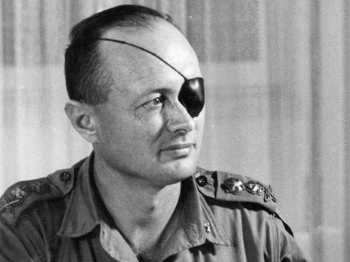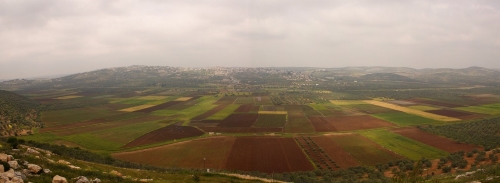The Course of the Six Day War
The Southern Front – The Egyptian Front

The Central Sector– The Jordanian Front
 On the morning of the first day of the war, the Jordanians opened fire with small arms and artillery and mortar shelling. The Jordanian Air Force fired on the entire sector, including Tel Aviv. Limited IDF forces were positioned opposite the Jordanian forces since most of the army was concentrated on the Egyptian front. Nevertheless, within three days the IDF forces conquered all of Judea and Samaria, including East Jerusalem. The remaining Jordanian forces retreated to the eastern side of the Jordan River. Judea and Samaria were captured with hardly any battles (except for the Battle of the Dotan Valley), however, fierce battles were waged in Jerusalem.
On the morning of the first day of the war, the Jordanians opened fire with small arms and artillery and mortar shelling. The Jordanian Air Force fired on the entire sector, including Tel Aviv. Limited IDF forces were positioned opposite the Jordanian forces since most of the army was concentrated on the Egyptian front. Nevertheless, within three days the IDF forces conquered all of Judea and Samaria, including East Jerusalem. The remaining Jordanian forces retreated to the eastern side of the Jordan River. Judea and Samaria were captured with hardly any battles (except for the Battle of the Dotan Valley), however, fierce battles were waged in Jerusalem.

Lyrics: YoramTeharlev | Music:Yair Rosenblum
The darkness faded out in the east.
We were deep in the battle over
Givat Hatachmoshet.
It was a
fierce battle.
The Jordanians were hard to crack.
It was a well-fortified bunker; in some stages of the battle,
I had only
four soldiers with me.
We came up there with two companies.
I never knew where the others were because the radio was with
Dudik, the commander was cut off from the beginning of the battle,
at that moment I was
sure that everyone was killed.
It was 2:30 at night
when we came through the rocks
to the fields of fire and mines
of Givat Hatachmoshet.
In front of fortified bunkers
machine guns and cannons
100 and few guys in front
of Givat Hatachmoshet.
The pillar of dawn didn’t rise yet
When all the company was already covered with blood
But we were there
on Givat Hatachmoshet.
The Jerusalem Front
The battle for Jerusalem was waged in the first 72 hours of the Six Day War between the IDF and the Jordanian Legion. On June 5, at 9:40, the war in Jerusalem began when the Jordanian army opened fire with small arms and then followed with heavy shelling of West Jerusalem, where Israel exercised sovereignty. Nevertheless, Israel responded with moderate measures and attempts to hold direct or indirect talks in order to prevent escalation. Through U.N. mediation, a ceasefire was achieved, but shortly thereafter, it was violated by Jordan when it conquered Armon Hanatziv. Israel counterattacked and reconquered Armon Hanatziv.

This was a turning point as from that point on Israel was on the offense until the end of the battles. Jerusalem Brigade forces (Brigade 16), supported by tanks, went on to conquer the mountains south of Armon Hanatziv and additional Jordanian positions, reaching Kibbutz Ramat Rachel. Meanwhile, the Harel Brigade was advancing from the west, towards northern Jerusalem. During the first night, they captured Hardar, north of Ma’ale Hahamisha and the valley up to the mountain ridge. By the next morning, Brigade 55 had opened the Ammunition Hill road, the Sheikh Jarrah neighborhood and Shechem (Nablus) Road, reaching the Rockefeller Museum.
During the second day, June 6, the Harel Brigade advanced in the south and captured Givat Hamivtar. On that same afternoon, the Jerusalem Brigade captured the Arab Abu Tor neighborhood. That night the Israeli air force bombed Jordanian reinforcements that were trying to reach Jerusalem from the direction of Jericho. On the morning of June 7, Brigade 55, supported by the Harel Brigade, captured the area from Augusta Victoria till the Mount of Olives. On the morning of June 7, at 11:00, two infantry brigades entered the Old City. Paratroopers from Brigade 55 entered through the Lions’ Gate and reached the Temple Mount and the Western Wall. Soldiers from the Jerusalem Brigade entered the Old City through Dung Gate and freed the Jewish Quarter. In the battles for Jerusalem, Israel lost 182 soldiers, about one quarter of all the soldiers who fell in the Six Day War.
The Northern Front – The Syrian Front
 Throughout the war, the settlements in the Hula Valley were bombed by the Syrians. On Tuesday, June 6, 1967, a Syrian tank battalion tried to attack Tel Dan and Kibbutz Dan. The attack was repelled by the regional defense forces, infantry forces and tank units that were stationed in the area. Only on June 9, after the battles had ended on the Egyptian front and the Jordanian front, was it possible to concentrate enough forces from all over the country and to send reinforcements to the Syrian front. In the morning hours of that day, the Israeli air force heavily and continuously barraged the Golan Heights. At the same time, seven brigades, commanded by the commander of the Northern Command, General David Elazar, attacked the Golan Heights. On June 10, at 2:00, the fighting on the Syrian front ended and the war was over.
Throughout the war, the settlements in the Hula Valley were bombed by the Syrians. On Tuesday, June 6, 1967, a Syrian tank battalion tried to attack Tel Dan and Kibbutz Dan. The attack was repelled by the regional defense forces, infantry forces and tank units that were stationed in the area. Only on June 9, after the battles had ended on the Egyptian front and the Jordanian front, was it possible to concentrate enough forces from all over the country and to send reinforcements to the Syrian front. In the morning hours of that day, the Israeli air force heavily and continuously barraged the Golan Heights. At the same time, seven brigades, commanded by the commander of the Northern Command, General David Elazar, attacked the Golan Heights. On June 10, at 2:00, the fighting on the Syrian front ended and the war was over.

